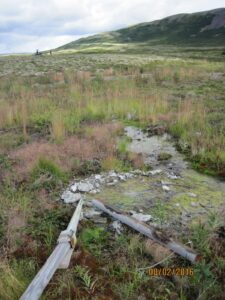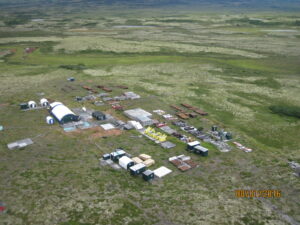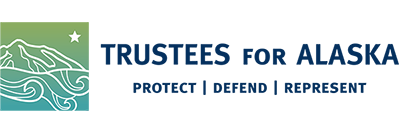
Pebble is Leaving a Mess for Alaskans to Cleanup
Earlier this month, Pebble Limited Partnership (Pebble) asked the Department of Natural Resources (DNR) for a new two-year permit. This new permit, just like the one that expires at the end of this year, would allow Pebble to keep storing its equipment and materials out in the field.

This site is an example of wetland
contamination and of the need to
inspect and correctly classify drill
sites. Photo: David Chambers, Center for Science in Public Participation
According to Pebble, the company has complied with all legal requirements for cleaning up the mess from their exploration work. We were skeptical, having seen the evidence in our 2010 trial against the State. Last year, Trustees started working with several organizations from the region to pressure DNR about its lax oversight of Pebble’s reclamation efforts. Not surprisingly, after an inspection this summer, DNR still found that Pebble was in full compliance with its permit.
However, in early November, United Tribes of Bristol Bay (UTBB) released the results from its own independent inspection of the Pebble site. This inspection found that 71 out of the 107 drill sites inspected were not in compliance with statutory requirements and Pebble’s permit conditions.
Since 1988, Pebble has been conducting exploration in Bristol Bay. Over the last three decades, Pebble has drilled 1,355 holes in the Pebble deposit area. This exploratory drilling and associated staging activities—with some drill holes more than a mile deep and within 100 feet of waterbodies—have not been properly cleaned up and are potentially harmful to Bristol Bay.
Past and recent field reports from DNR show that many of Pebble’s drill sites may not have been properly plugged, reclamation and re-vegetation efforts have been unsuccessful in many locations, and potentially toxic drilling fluids and muds have been mishandled and allowed to be deposited directly onto the tundra.
UTBB’s recent inspection report further documented “acidic soils with high metal concentrations, leaking wells, dead vegetation, and improper drill casing closures at inspected drill sites; all causes of concern for safety and water quality in Bristol Bay.”

The main camp contains drill pipe, buildings, tanks, and other supplies. Photo: David Chambers, Center for Science in Public Participation
Pebble stopped its exploration activities in fall 2013. For the past three years, Pebble has been storing its equipment and materials, and maintaining camp facilities on public land. Pebble must have a permit from the State to continue to do this. With exploration on hold indefinitely, the only activity currently occurring at the site is sporadic attempts at clean-up of some well sites that Pebble has identified as having recurring problems.
Pebble has no plans to conduct any more exploration. And, after more than a decade of promises to move beyond the exploration phase, they have no concrete plans to get a mine plan approved. They also have no plans to remove their equipment and other waste from the field. In essence, Pebble is using public land as a storage facility for practically no cost.
Pebble has stalled out because they are short on money. By 2014, all of the major financial backers of the project pulled out. As of March of this year, Pebble was running an almost $390 million deficit. The company is barely able to bring in enough cash each quarter to pay their bills. And, to top it all off, all the cash they do bring in is being spent on lawyers challenging the U.S. Environmental Protection Agency’s efforts to protect Bristol Bay. Pebble is spending little, if any, money cleaning up its mess.
Now, Pebble is asking for another permit so the company can continue to keep its equipment in the field through the end of 2018. While this new permit would generally require Pebble to comply with the law and permit conditions regarding clean-up and repair of the areas impacted by Pebble’s exploration activities, Pebble cannot be trusted to comply with these requirements.
DNR has a history of rubber stamping Pebble’s permit applications. It is unlikely that this new permit would require Pebble to take any steps to remove unnecessary equipment from the field or to test for ongoing contamination problems from its 1,355 holes. However, for the first time, and as a result of Trustees’ litigation, there is a 30-day public comment period for this new permit application. The public has until November 30th to submit comments to DNR.
This is an opportunity to tell DNR that it is time to hold Pebble responsible for its mess and address the concerns raised by UTBB’s report. It’s also time that Pebble be required to post a financial bond to ensure there is money available to clean up what’s left on state land if Pebble goes belly-up. Pebble’s dire financial status makes this imperative. Indeed, as the recent UTBB report has shown, Pebble has a lot of work to do to clean up its mess and cannot be trusted to accurately self-assess the condition of the sites without more robust oversight from the State.
Please take action to by November 30th to request that DNR require a permit that makes Pebble clean up its mess and make the site safe.
The public notice is available here.
UTBB Press Release
CLIENTS: Nunamta Aulukestai
ATTORNEYS: Michelle Sinnott, Valerie Brown


